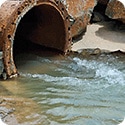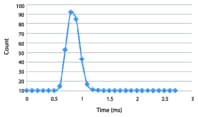Access Agilent eNewsletter July 2015
>> Update My Profile | Subscribe to Access Agilent | Article Directory

Characterization and quantification of nanoparticles with Agilent ICP-MS environmental solutions
By Craig Marvin
Agilent Global Environmental Industry Manager
Nanoparticles are microscopic particles, either naturally occurring or engineered, of any shape with dimensions around 10-9 to 10-7 m (IUPAC). Manmade nanoparticles enhance the performance or properties of products ranging from semiconductor materials to foods, drugs, cosmetics, and consumer goods. Because of their novel physical and chemical characteristics, much remains unknown of their environmental fate and toxicological properties. The use of nanoparticles as delivery vehicles for herbicides, pesticides, and fertilizers in agricultural applications raises concern about their appearance in the food supply and potential contamination of the environment. As a result, there is a growing need for a rapid, accurate, and sensitive technique for characterizing and quantifying nanoparticles in many sample types.
Higher sensitivity nanoparticle analysis with ICP-MS
Compared to other techniques used for nanoparticle research, inductively coupled plasma mass spectrometry (ICP-MS) delivers the sensitivity and specificity required to characterize nanoparticle content, and the resolution to evaluate the characteristics of single nanoparticles. ICP-MS is a rapid analytical technique that requires limited sample preparation. It can characterize nanoparticles by two different strategies – single particle ICP-MS or hyphenated ICP-MS.
 Enlarge
Enlarge
Figure 1. Particle transport from sample to ICP‑MS interface and resulting time-resolved signal generated by the mass spectrometer.
Easily detect and quantify single particles
Single particle ICP-MS directly detects and quantifies the signal generated from the atomization and ionization of a single particle introduced to the plasma. The droplet that contains the single particle is sequentially desolvated, followed by component atomization and ionization. The resulting plume of ions enters the MS where the ions are separated by m/z and detected through time-resolved analysis (TRA) (Figure 1). The ion intensity is proportional to the mass of the target elements in the original particle, allowing for the determination of theoretical particle size and the concentration (number) of particles.
The Agilent white paper Characterizing nanoparticles in aqueous samples (5991-5516EN) demonstrates the strength of ICP-MS for nanoparticle analysis compared to alternative analytical technologies.
 Enlarge
Enlarge
Figure 2. Measurement of one single 100 nm Ag nanoparticle with 100 µs integration.
Optimized analysis with Agilent 7900 ICP-MS
To determine the content of nanoparticles in a sample, integration time of the ICP-MS should be optimized to collect the entire signal from one nanoparticle while avoiding partial measurement of a particle. The integration time must also ensure that the particle signal can be accurately discriminated from the background. Conversely, integration time must be short enough to avoid measuring two nanoparticles in a single integration period, since that would overestimate the size of the nanoparticles and underestimate the particle number. To satisfy these requirements, typical recommended integration (or dwell) times range from 1 to 10 ms per point.
Now, the latest generation of ICP-MS systems such as the Agilent 7900 ICP-MS, allow the use of shorter dwell times (below 1 ms). This eliminates the settling time between measurements. A short integration time, such as 100 µs, enables the measurement of several data points across the signal pulse from the ion cloud created as a single nanoparticle passes through the plasma (Figure 2). In contrast, with an integration time of 3 ms, the entire signal pulse from an individual nanoparticle is contained in one TRA measurement and reported as single intensity.
Learn more about single particle analysis of nanomaterials using the Agilent 7900 ICP-MS in Agilent application note 5991-4401EN.
Hyphenated ICP-MS removes interference from complex matrices
In a hyphenated system, ICP-MS is used as a sensitive, element-specific detector after an online separation step, such as capillary electrophoresis. CE-ICP-MS requires smaller sample sizes, provides a high degree of resolution, and much shorter run times than field flow fractionation. Hyphenation with ion, liquid, and gas chromatography systems is also possible.
For example, Agilent publication 5991-5513EN describes use of CE-ICP-MS for identification and accurate size characterization of nanoparticles in consumer products and environmental water samples. The data provides multidimensional information related to chemical composition and size distribution of multiple nanoparticles, together with the level of ionic species present in a sample, all acquired in a single run.
The data from our study shows good recovery of silver nanoparticles (88.2 to 95.2%) with a slight aggregation of Ag nanoparticles (Table 1). Concentrations of nanoparticle in consumer products and environmental or clinical samples are normally very low. For example, predicted environmental concentrations for Ag nanoparticles in different environmental samples range from ng L-1 to mg kg-1 (Fabrega et al. Environ. Int. 37, 2011). Common techniques, such as transmission electron microscopy and dynamic light scattering, cannot identify particle composition or measure dissolved ionic species, whereas CE-ICP-MS is a more sensitive tool.
Ag NP spiked |
River water |
Waste water |
||
|---|---|---|---|---|
Recovery (%) |
Measured particle size (nm)a |
Recovery (%) |
Measured particle sizrticle size (nm)a |
|
10 nm Ag NPs |
92.9±1.6 |
16.4±12.1 |
95.2±2.1 |
15.9±10.3 |
20 nm Ag NPs |
91.6±2.2 |
28.3±8.8 |
89.6±2.4 |
22.4±17.2 |
40 nm Ag NPs |
88.2±2.9 |
51.8±6.4 |
91.5±3.2 |
49.4±11.3 |
a) Mean particle sizes measured by CE-ICP-MS were slightly larger than the nominal sizes of the spiked Ag nanoparticles, indicating that slight aggregation of Ag nanoparticles occurred, induced by matrix complexity
Table 1. Recoveries, precision (n = 3), and size characterization of Ag nanoparticles in river water and wastewater.
Agilent enables environmental analysis with speed, accuracy, and productivity
Agilent has over 40 years of environmental analysis and regulatory expertise. If you are involved in the measurement of organic and inorganic chemicals in water, soil, air, or food supplies, Agilent has the right instruments, accessories, consumables, and services for you, designed specifically to meet your needs.
Our comprehensive and trusted portfolio of products and services, including ICP-MS and Hyphenated ICP-MS, offer diverse solutions in application areas such as environmental and agriculture analysis. Contact your Agilent Representative today to find out more.
>> Update My Profile | Subscribe to Access Agilent | Article Directory

